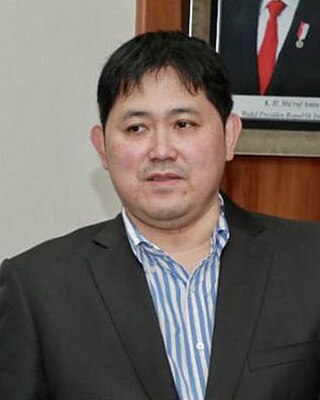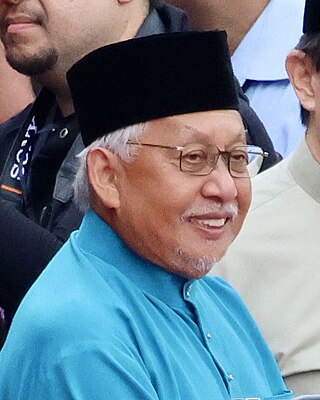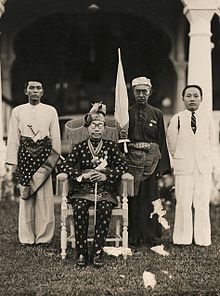The Malay language has a complex system of styles, titles and honorifics which are used extensively in Brunei Darussalam, Malaysia and Singapore.

Mohamed Bolkiah ibni Omar Ali Saifuddien III is a member of the royal family of Brunei. He is the second son of Omar Ali Saifuddien III, the 28th Sultan of Brunei, and Raja Isteri (Queen) Pengiran Anak Damit. He is the Head of the Brunei’s Viziers. After Brunei’s independence in 1984, he became the country’s first foreign minister, serving from 1 January 1984 until 22 October 2015. He served in the cabinet as the Minister of the Brunei's Ministry of Foreign Affairs and Trade alongside the second Minister of Foreign Affairs and Trade, Lim Jock Seng.

Omar Ali Saifuddien Sa'adul Khairi Waddien was the 28th Sultan of Brunei, reigning from 1950 until his abdication in 1967.

Al-Muhtadee Billah ibni Hassanal Bolkiah is the eldest son of Sultan Hassanal Bolkiah and his wife Queen Saleha. He is the Crown Prince of Brunei Darussalam, and is first in the line of succession to the Bruneian throne.
Omar Ali Saifuddin I ibni Muhammad Alauddin, also known as Al-Marhum Makam Besar, was the 18th Sultan of Brunei and the second son of Sultan Muhammad Alauddin. He was regarded as one of the longest-serving sultans and was renowned for his wise leadership and just rule, merely following his father-in-law, Sultan Hussin Kamaluddin. In fact, he received helpful knowledge, counsel, and experience from his father-in-law when he was still alive during his reigning period.

Bendahara is an administrative position within classical Malay kingdoms comparable to a vizier before the intervention of European powers during the 19th century. A bendahara was appointed by a sultan and was a hereditary post. The bendahara and the sultan shared the same lineage.

The Royal Brunei Mausoleum is a Royal Mausoleum of Brunei located at Jalan Tutong, Bandar Seri Begawan, Brunei. The Mausoleum is the main resting place and burial ground for several Sultans of Brunei and members of the Royal Family. The Royal Mausoleum was opened during the reign of Sultan Omar Ali Saifuddin I who later became the first monarch to be buried in the Mausoleum when he died in 1795.

Pengiran Anak Mohamed Alam OBE was a nobleman and politician whom became the fourth Speaker of the Brunei Legislative Council, serving from 14 July 1971 until 30 November 1974. He was the father of Pengiran Anak Saleha, the queen consort of Hassanal Bolkiah, the current Sultan of Brunei. He was also the uncle and father-in-law of the Sultan. He was also a maternal grandfather of Al-Muhtadee Billah, the Crown Prince.

Batu Satu, also known as Kampong Parit, is an area in Bandar Seri Begawan, the capital of Brunei. It is also a designated village in Brunei-Muara District, within Mukim Kianggeh. The population was 1,509 in 2016. It encompasses a commercial area of the capital. It is also home to the country's Supreme Court, as well as some of important Islamic religious educational institutions of the country.
The Most Esteemed Family Order of Laila Utama is an order of Brunei. It was established on 1 March 1954 by Sultan Omar Ali Saifuddien III. The order carries the post-nominal letters "DK" or "DK I" as well as the title "Dato Laila Utama".

Abdul Qawi ibni Mohamed Bolkiah is a member of the Brunei royal family. He is a nephew of the current Sultan of Brunei, Sultan Hassanal Bolkiah.

Tengku Raihani was Queen of Brunei as the wife of the 27th Sultan of Brunei, Ahmad Tajuddin. She is the daughter of Sultan Sulaiman of Selangor and one of his consorts, Cik Puan Maimunah binti Abdullah.

Pengiran Anak Damit was Queen of Brunei as the wife of the 28th Sultan of Brunei, Omar Ali Saifuddien III.

Pengiran Anak Hashim, also simply referred to as P. M. Hashim, was a Bruneian nobleman and politician who formerly held several high-ranking positions which included being a member of the Privy Council, Legislative Council, and the Islamic Religious Council.

Pengiran Mokhtar Puteh CVO or also spelled Mokhtar Putih, was a nobleman and a civil servant from Brunei who served in several high-ranking positions which included being a member of the Privy Council and vice-president of the Brunei Darussalam National Olympic Council. He was known for his active involvement in charitable work and sport activities throughout his life.
Princess Nor Ehsani or sometimes spelled Noor Ehsani, is the only child and daughter of Sultan Ahmad Tajuddin and Queen Tengku Raihani.

Pengiran Anak Muhammad Bey Muntassir was a member of the royal family of Brunei as the husband of Princess Amal Jefriah Bolkiah, the sixth daughter of Sultan Omar Ali Saifuddien III, and brother-in-law to Sultan Hassanal Bolkiah. Additionally, he was also a member of the Brunei Privy Council.

Pengiran Anak Siti Saerah or also referred to as Balabab Besar, was the eldest child and daughter of Sultan Ahmad Tajuddin and Kadayang Amas. Additionally, she was the eldest granddaughter of Sultan Muhammad Jamalul Alam II and Raja Isteri Fatimah, and first cousin to the current Brunei's Sultan Hassanal Bolkiah.

Pengiran Anak Idris is a Bruneian nobleman and member of the royal family who became the prince consort to Princess Amal Umi Kalthum Al-Islam in 1972, the daughter of Sultan Omar Ali Saifuddien III. He is the current Chief of the Royal Customs and Protocols Department, a member of the Privy Council of Brunei, and assistant chairman of the Royal Customs and Protocols Council, and Yayasan Sultan Haji Hassanal Bolkiah's board of governors.



















